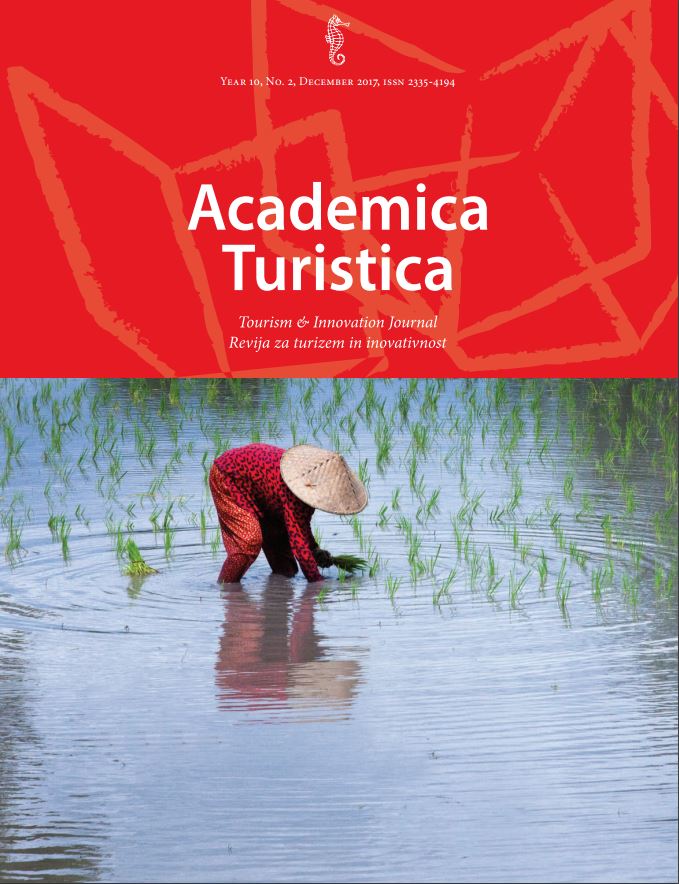Business Model Innovation in Tourism: How to Survive in Highly Competitive Environments
Abstract
The objective of this research is to clarify the role and the importance of the business model in tourism and to demonstrate the necessity of changing the business model to maintain competitiveness. By employing the Osterwalder nine-block business model Canvas framework, an interview with the manager of Slovenian tourist agency was conducted. Without the innovation of individual segments of the business model or, more often the majority of its dimensions, the firm would not have survived. In our case, the necessity of innovating the business model was confirmed by the statement of the agency’s manager: ‘In any case, without changes, we would no longer exist on the market; without future changes, we will no longer exist on the market either.’ This article presents a single case study; therefore, the results may have limited generalisability. Everyday changes in competitive markets should be met by the innovation of business models. Tourism firms must be able to articulate and innovate their business model if they want to survive in a rapidly evolving competitive global market. Although studies on business modelling are common in the tourism sector, little about them has been documented regarding the tourism sector in Slovenia. Hence, this study, which focuses on a Slovenian tourist agency, aims to fill this knowledge gap. Our case is particularly interesting, because we have demonstrated the interdependence of segments and their modification, we have shown that the business model is already present in the tourist agency, and we articulated it.
References
Ambrož, R. (2015). The importance of innovation business model in achieving competitiveness (Unpublished master thesis). University of Primorska, Koper, Slovenia.
Amit, R., & Zott, C. (2012). Creating value through business model innovation. mit Sloan Management Review, 53(3), 41–49.
Baden-Fuller, C., & Mangematin, V. (2013). Business models: A challenging agenda. Strategic Organization, 11(4), 418–427.
Casadesus-Masanell R., & Ricart, J. E. (2010). From strategy to business models and onto tactics. Long Range Planning, 43, 195–215.
Casadesus-Masanell, R., & Heilbron, J. (2015). The business model: Nature and benefits (Working Paper No. 15-089). Harvard Business School, Boston, ma.
Chesbrough, H. (2007). Business model innovation: It’s not just about technology anymore. Strategy & Leadership, 35(6), 12–17.
Chesbrough, H., & Rosenbloom, R. S. (2002). The role of the business model in capturing value from innovation: Evidence from Xerox corporation’s technology. Industrial and Corporate Change, 11(3), 529–555.
Euchner, J., & Ganguly, A. (2014). Business model innovation in practice: A systematic approach to business model innovation can help capture value and reduce risks. Research-Technology Management, 57(6), 33–39.
Gebauer, J., & Ginsburg, M. (2003). The us wine industry and the Internet: An analysis of success factors for online business models. Electronic Markets, 13(1), 59–66.
Linder, J., & Cantrell, S. (2000). Changing business models: Surveying the landscape. Cambridge, ma: Accenture Institute for Strategic Change.
Lindgardt, Z., Reeves, M., Stalk, G., & Deimler, M. S. (2009). Business model innovation: When the game gets tough, change the game. Retrieved from: https://www.bcg.com/documents/file36456.pdf
Magretta, J. (2002). Why business models matter. Harvard Business Review, 80(5), 86–92.
Martins, L. L., Rindova, V. P., & Greenbaum, B. E. (2015). Unlocking the hidden value of concepts: A cognitive approach to business model innovation. Strategic Entrepreneurship Journal, 9(1), 99–117.
Matzler, K., Bailom, F., Friedrich, S., & Kohler, T. (2013). Business model innovation: Coffee triumphs for Nespresso. Journal of Business Strategy, 34(2), 30–37.
Najmaei, A. (2011, 19–21 August). Dynamic business model innovation: An analytical archetype. Paper presented at the 3rd International Conference on Information and Financial Engineering ipedr, Shanghai, China.
Osterwalder, A., & Pigneur, Y. (2010). Business model generation.
Hoboken, nj: Wiley. Osterwalder, A., Pigneur, Y. & Tucci, C. L. (2005). Clarifying business models: Origins, present, and past future of the concept. Communications of the Association for Information Systems, 16, 1–25.
Teece, D. J. (2010). Business models, business strategy andm innovation. Long Range Planning, 43(2–3), 172–194. Tikkanen, H., Lamberg, J. A.,
Parvinen, P., & Kallunki, J. P. (2005). Managerial cognition, action and the business model of the firm. Management Decision, 43(5/6), 789–809.
Timmers, P. (1998). Business models for electronic markets. Electronic Markets, 8(2), 3–8.
V
erma, D. P. S., & Varma, G. (2003). On-line pricing: Concept, methods and current practices. Journal of Services Research, 3(1), 135–155.
Zott, C., Amit, R., & Massa, L. (2010). The business model: Theoretical roots, recent developments, and future research (Working Paper wp-862). University of Navarra, iese Business School, Barcelona, Spain.
Yip, G. S. (2004). Using strategy to change your business model. Business Strategy Review, 15(2), 17–24.
Yunus, M., Moingeon, B., & Lehmann-Ortega, L. (2010). Building social business models: Lessons from the Grameen experience. Long Range Planning, 43(2/3), 308–325.
Wensveen, J. G., & Leick, R. (2009). The long-haul low-cost carrier: A unique business model. Journal of Air Transport Management, 15(3), 127–133.
Downloads
Published
How to Cite
Issue
Section
License
1. Copyright
Copyright for all articles published in Academica Turistica - Tourism and Innovation Journal is held by individual authors. Authors are themselves responsible for obtaining permission to reproduce copyright material from other sources.
Upon acceptance of an article, authors will be asked to complete the Publication Agreement and Copyright Licence, based on the Open Access Model Publishing Agreement.
Articles are published under the terms of the Creative Commons CC BY-NC-ND 4.0 License.
Under the terms of this license, authors retain ownership of the copyright of their articles. They can archive the pre-print and post-print or publisher's version of their work. They will, however, assign to Academica Turistica - Tourism and Innovation Journal (AT–TIJ) the permanent right to electronically distribute their manuscript and, after it has appeared in AT–TIJ, they may republish their text as long as they clearly acknowledge AT–TIJ as the place of the original publication.
2. Author Fees
Article submission, processing and/or publishing fees are not charged.



